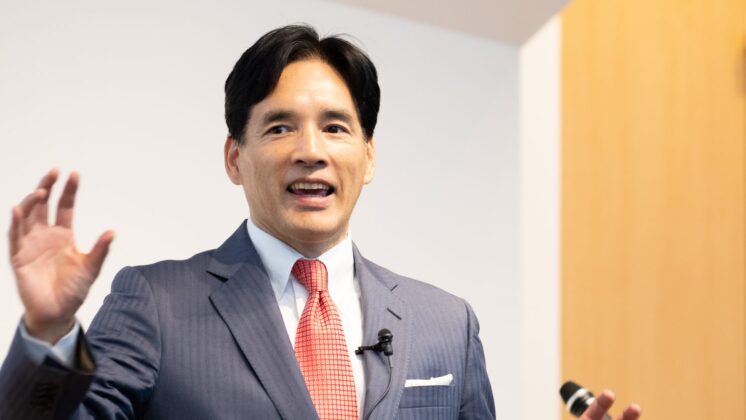The Group for Thinking about Art and Business is a volunteer group led by two GLOBIS students that was set up in 2004 with the aim of having Japan’s future business leaders gain a deeper appreciation of art. The artist Hiroshi Okano and I participated as panelists at an event on June 3, 2004.
Lots of people came, and you could feel the intense level of interest. I’ll be the first to admit that I’ve got nothing in my background that would enable me to talk about painting. My art grades at school were always low. As such, I had serious reservations about participating in a panel discussion with an actual artist. Prior to the event I asked someone with a deep knowledge of art to prepare a list of questions for me. I brought the list with me, all ready to go.
The opening video explored how Okano got into painting, the influence of other artists’ work on him, and the reason he had gone to study abroad in France. There were even scenes of him painting in his studio, including an explanation of his state of mind while he is painting.
This was fascinating. The problem was, the video covered most of the questions I had prepared to ask, which left me wondering what to do.
When the video finished, the MC introduced me, and the discussion began. I had hurriedly decided at the last minute to have Mr. Yoshihiko Noro, the president of the Ginza Yanagi Gallery, join us on stage as a panelist, with me serving as the moderator.
There were comments and questions from collectors and others in the audience. The session proceeded, the atmosphere was friendly, and I myself learned a great deal. (I don’t know if it’s good for the moderator to be learning so much, but I really did learn a lot at this session.)
Here’s a little of Okano’s wisdom:
“The most important element of painting is vitality.”
“Paint with the rhythm of your whole body. Paint in one motion so that none of your feeling slips away.”
“Trust your own intuition when choosing colors.”
“You have to be patient to appreciate a good painting. At first, they can seem impossible to understand.”
“The job of a painter is to paint what you feel in the moment.”
The last of these was the most fascinating to me. Okano cherishes impressions of colors captured in his mind, which he then recreates and transfers directly onto the canvas in a single stroke. He went on to say that “technique is not that important. You can always improve your technique by taking lessons. Painting is about feeling rather than technique. It’s about directly expressing what inspired you, in a way that is true to yourself.”
In the course of the discussion, I did talk a bit about business. (I can’t really talk about art, but I am very happy to talk about business.)
In fact, art is important in business. At GLOBIS, I explained, we teach business administration, but simply acquiring knowledge about management doesn’t mean you will understand how to put it into practice. It’s more important to be able to “paint” a vision, management principles, leadership, and the organizational culture. The vital components that make up these factors are a sense of excitement and passion. This passion moves us to “paint” a vision, become the source of energy for leading others, and nurture an organizational culture.
In management, the expression, “painting a picture,” is often used in the sense of creating a vision for the future. I believe this is like standing before a blank canvas and freely painting a picture, just like an artist. The more inspiring this painting or vision is, the more it will strike a chord in people’s hearts, which means more people will want to join in what you are doing. As a result, the painting or vision will find its completion.
I’ll include here a phrase that was featured in the afterword of a book I wrote in 1994, The Case-Method Approach to Strategic Entrepreneurship (Nikkei BP).
“Entrepreneurship is a dream, an art, and a science. At the same time, it is an extremely primal human process.”
Business begins with a dream. This dream is then constructed using science, then raised to the level of art. It’s like painting a picture. This picture is shared with many people, and from the resulting interaction of fellow humans, a business is created.
Art, as defined by Okano, is about “expressing your feelings exactly as they are.” Business, then, in the same way as art, requires us to feel genuinely moved, and then express ourselves boldly.
I suppose businesspeople must have the ability to be moved, as well as the artistic temperament for openly and sincerely expressing these feelings in one form or another.
With this on my mind, I made my way to the post-session party.
At the party, Okano, his wife, collectors, and gallery owners got together and delved more deeply into our discussion about art. We talked about what beauty is, which led to analyzing and exchanging opinions about the evolution of Okano’s paintings, and then into classical music. Okano beamed warmly as he listened to the discussion.
I returned home and took a moment to carefully look again at Okano’s paintings. The evening of the following day, on arriving at my mountain lodge in Karuizawa, I gazed at his paintings again, one at a time. I recalled Okano’s words regarding “vitality,” “boldly expressing one’s feelings,” and “trusting your own intuitions about color.”
Then, in the stillness, I basked for a while in the emotions welling up within me.



